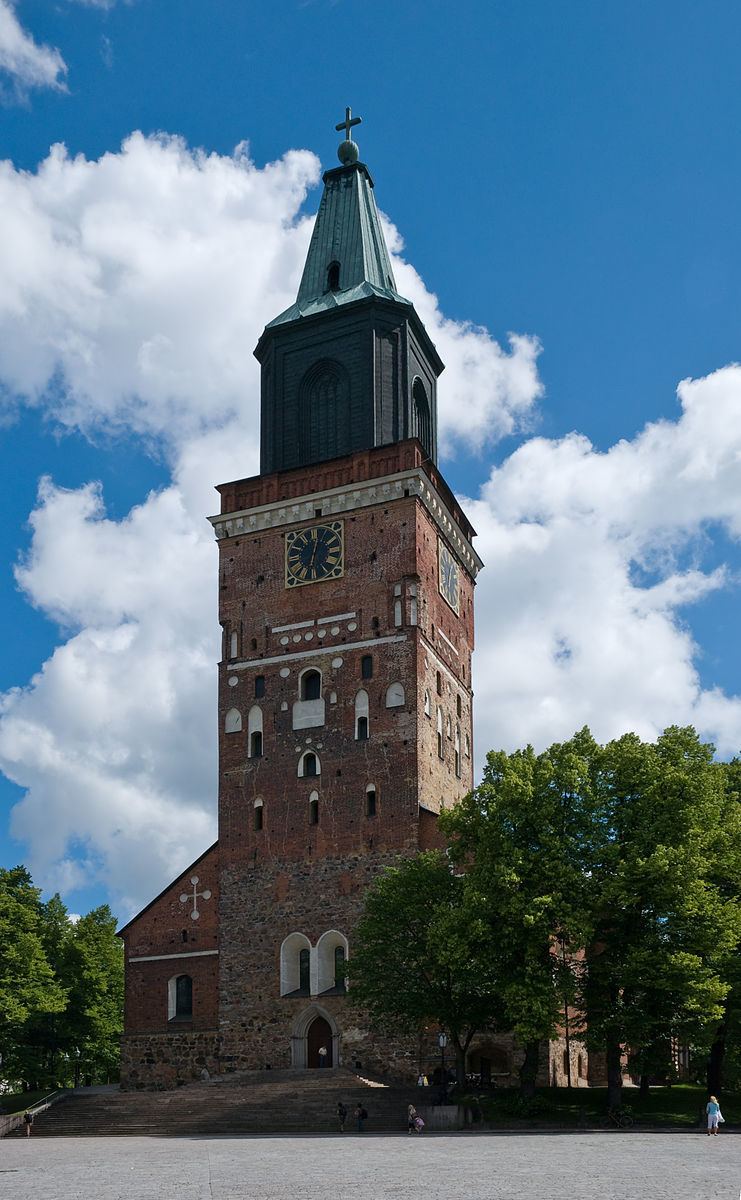Height 86 m | Website Official Website | |
 | ||
Dedication Blessed Virgin MarySaint Henry Address Tuomiokirkonkatu 1, 20500 Turku, Finland Architectural styles Gothic Revival architecture, Romanesque Revival architecture, Gothic architecture Similar Turku Castle, Mother Church of the Evan, Aboa Vetus & Ars Nova, Old Great Square, Luostarinmäki | ||
Turku cathedral
Turku Cathedral (Finnish: Turun tuomiokirkko, Swedish: Åbo domkyrkka) is the Mother Church of the Evangelical Lutheran Church of Finland. It is the central church of the Archdiocese of Turku and the seat of the Archbishop of Finland, Kari Mäkinen. It is also regarded as one of the major records of Finnish architectural history.
Contents
Considered to be the most important religious building in Finland, the cathedral has borne witness to many important events in the nation's history and has become one of the city's most recognizable symbols. The cathedral is situated in the heart of Turku next to the Old Great Square, by the river Aura. Its presence extends beyond the local precinct by having the sound of its bells chiming at noon broadcast on national radio. It is also central to Finland's annual Christmas celebrations.
The cathedral was originally built out of wood in the late 13th century, and was dedicated as the main cathedral of Finland in 1300, the seat of the bishop of Turku. It was considerably expanded in the 14th and 15th centuries, mainly using stone as the construction material. The cathedral was badly damaged during the Great Fire of Turku in 1827, and was rebuilt to a great extent afterwards.
258 turku cathedral
History
As the town of Turku began to emerge in the course of the 13th century as the most important trading centre in Finland, the Bishop's see of the Diocese of Finland was transferred from its previous location at Koroinen, some distance further up on the bank of Aura river, to the middle of the town. By the end of the 13th century, a new stone church had been completed on the site of the former wooden-built parish church on Unikankare Mound, and it was consecrated in 1300 as the Cathedral Church of the Blessed Virgin Mary and Saint Henry, the first Bishop of Finland.
At its earliest the cathedral was smaller than the present building. Its east front was where the pulpit stands now, and its roof was considerably lower than at the moment. Extensions were made to the cathedral throughout the Middle Ages. During the 14th century a new choir was added, from which the octagonal Gothic pillars in the present chancel originate. Throughout the Middle Ages, the High Altar was located opposite the easternmost pillars of the nave, until it was transferred to its present location in the apse, in what had previously been the Chapel of All Saints, in the mid-17th century.
During the 15th century, side-chapels were added along the north and south sides of the nave, containing altars dedicated to various saints. By the end of the Middle Ages these numbered 42 in total. The roof-vaults were also raised during the latter part of the 15th century to their present height of 24 meters. Thus, by the beginning of the Modern era, the church had approximately taken on its present shape. The major later addition to the cathedral is the tower, which has been rebuilt several times, as a result of repeated fires. The worst damage was caused by the Great Fire of Turku in 1827, when most of the town was destroyed, along with the interior of both the tower and the nave and the old tower roof. The present spire of the tower, constructed after the great fire, reaches a height of 101 meters above sea level, and is visible over a considerable distance as the symbol of both the cathedral and the city of Turku itself.
Most of the present interior also dates from the restoration carried out in the 1830s, following the Great Fire. The altarpiece, depicting the Transfiguration of Jesus, was painted in 1836 by the Swedish artist Fredrik Westin. The reredos behind the High Altar, and the pulpit in the crossing, also both date from the 1830s, and were designed by german architect Carl Ludvig Engel, known in Finland for his several other highly regarded works. The walls and roof in the chancel are decorated with frescos in the Romantic style by the court painter Robert Wilhelm Ekman, which depict events from the life of Jesus, and the two key events in the history of the Finnish Church: the baptism of the first Finnish Christians by Bishop Henry by the spring at Kupittaa, and the presentation to King Gustav Vasa by the Reformer Michael Agricola of the first Finnish translation of the New Testament.
The Cathedral houses three organs. The current main organ of the Cathedral was built by Veikko Virtanen Oy of Espoo, Finland, in 1980 and features 81 ranks with a mechanical action.
